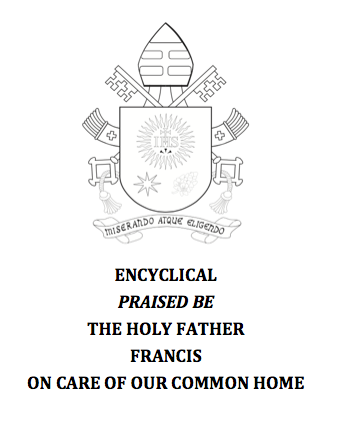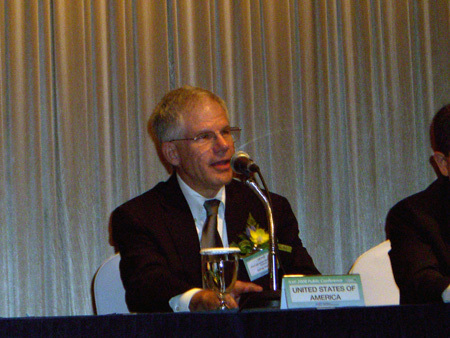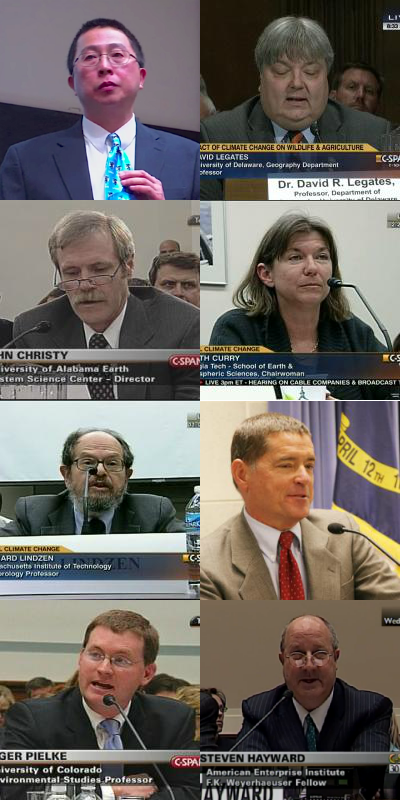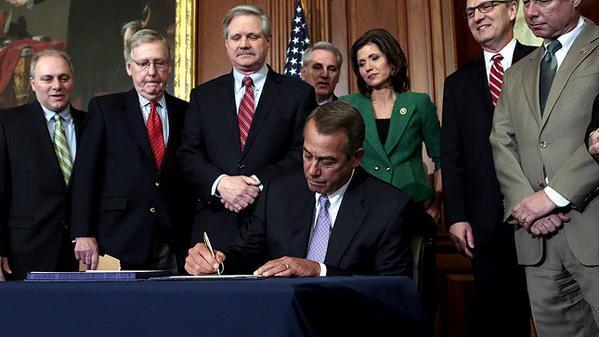
AMS Executive Director Keith Seitter
The American Meteorological Society’s executive director, Keith Seitter,
has
condemned
a Congressional investigation of the potential corruption of scientific
testimony on climate change by AMS members.
The investigation was launched by Rep. Raul Grijalva (D-Ariz.) following
the revelations that the research of Dr. Willie Soon of the
Harvard-Smithsonian Astrophysical Laboratory was secretly financed by
the fossil-fuel industry, including Koch Industries, Exxon Mobil, and
Southern Company. Soon testified before Congress in 2003 questioning the
scientific consensus on fossil-fueled global warming.
Grijalva sent
letters
to the universities of seven other academics who have been Republican
witnesses challenging the climate-science consensus, asking for
testimony-related financial disclosure. Seitter responded by condemning
the
investigation.
“Publicly singling out specific researchers based on perspectives they
have expressed and implying a failure to appropriately disclose funding
sources — and thereby questioning their scientific integrity — sends a
chilling message to all academic researchers,” Seitter wrote in the AMS
response.
“Further, requesting copies of the researcher’s communications related
to external funding opportunities or the preparation of testimony
impinges on the free pursuit of ideas that is central to the concept of
academic freedom.”
Not mentioned by Seitter is that six of the seven targets of the
Grijalva investigation are AMS members.
Judith Curry was elected a Fellow of AMS in 1995 and a councillor of AMS
in 1997. John Christy received a Special Award from AMS in 1996, and was
elected a Fellow in 2002. David Legates has been the faculty advisor to
the Student Chapter of AMS and is an AMS certified consulting
meteorologist. Richard Lindzen has received AMS’s Meisinger and Charney
Awards and was a member of the AMS Council. Robert Balling is a member
and frequent presenter at AMS conferences. Roger Pielke Jr is an AMS
member.
Pepperdine and American Enterprise Institute historian Steven Hayward is
the only investigative target not in the American Meteorological
Society.
These AMS members are notable for their public denunciation of the
scientific community and specific scientists, including other members of
AMS.
Below are some examples.
“The problem is that Obama is listening to scientists that are either
playing politics with their expertise, or responding to a political
mandate from the administration (probably a combination of both). Not
just administrators in govt labs (e.g. [Gavin] Schmidt, [Tom]
Karl), but think of the scientist networks of John Holdren and John
Podesta: to me the scariest one one is [Michael] Mann to [Joseph]
Romm to Podesta.” - Judith Curry,
1/21/15
“When you’re an alarmist, being wrong, lying, cheating, misleading the
public and killing jobs simply do not count against you — even when
the allegedly human-caused global warming stopped in 1996.” - David
Legates,
10/16/13
“[The hacked University of East Anglia email correspondence] is
clear proof of what we have suspected: That these thugs have
strong-armed and subverted the peer review process by demanding they
be reviewers of papers critical of their work, removing editors who
are not predisposed to their views, and even threatening to boycott
journals that publish papers with which they disagree.” - David
Legates,
1/18/10
“Because this issue has policy implications that may potentially raise
the price of energy significantly (and thus essentially the price of
everything else), the U.S. Congress should not rely exclusively on the
U.N. assessments because the process by which they were written
includes biased, false, and/or misleading information about one of the
most murky of sciences – climate.” - John Christy,
3/31/11
“[The Draft National Assessment on Climate Change] is much closer to
pseudoscience than it is to science. . . . History tells us that when
scientists willingly endorse sweeping governmental agendas fueled by
dodgy science, bad things soon happen.” - Robert Balling,
4/15/13
“It is quite amazing to see the contortions the IPCC has to go through
in order to keep the international climate agenda going.” - Richard
Lindzen,
9/28/13
“Current global warming alarm hardly represents a plausible
proposition. Twenty years of repetition and escalation of claims does
not make it more plausible. Quite the contrary, the failure to improve
the case over 20 years makes the case even less plausible as does the
evidence from climategate and other instances of overt cheating.” -
Richard Lindzen, Congressional testimony,
11/17/10
Hill Heat has previously compiled a list of dozens of
attacks
made by Roger Pielke Jr, a political scientist, against climate
scientists.
Roger Pielke Sr, Pielke Jr’s father and another climate scientist who
has testified before Congress rejecting the climate science consensus,
was elected a Fellow of AMS in 1982. Pielke Sr was a member of the AMS
Committee for Statements on Weather Modification. AMS’s official
statement on climate
change was issued
in August 2012, after significant delay. Pielke Sr was a likely source
of such delay, as he strongly
advocated
for changes to weaken the statement. Pielke Sr has
accused
fellow AMS members including Tom Karl, Ben Santer, Tom Peterson, Tom
Wigley, and Peter Thorne of “inappropriate” behavior, “collusion,” and
“conflicts of interest” to suppress dissenting views [his].
This is not the first time the executive director of the AMS has
criticized efforts to hold climate deniers publicly accountable.
Seitter previously
criticized the
science-activist organization Forecast the
Facts for
“apply[ing] public pressure” on “broadcast meteorologists who are
identified as ‘deniers’ based on views they have expressed with respect
to climate change.”
Dozens of television weather reporters who have attacked climate science
and scientists are AMS members. At least twenty television weathermen
who publicly reject basic climate science are AMS Certified Broadcast
Meteorologists, the society’s seal of approval granting them scientific
legitimacy in their role as weather and climate communicators.
“The AMS maintains that peer-review is the appropriate mechanism to
assess the validity and quality of scientific research,” Seitter wrote,
“regardless of the funding sources supporting that research as long as
those funding sources and any potential conflicts of interest are fully
disclosed.”
The pursuit of that disclosure is, of course, the stated purpose of
Grijalva’s investigation, as the scientific community failed to ensure
such disclosure in the case of Willie Soon.
According to the AMS
bylaws:
Members should conduct themselves in an ethical manner and reflect
dignity and honor on their profession. Members should base their
practice on sound scientific principles applied in a scientific
manner. Members should not direct their professional activities into
practices generally recognized as being detrimental to, or
incompatible with, the general public welfare. Members should refrain
from making exaggerated or unwarranted claims and statements.
Either the claims made by AMS and the rest of the global scientific
community are exaggerated, unwarranted, and detrimental to the general
public welfare, or the claims of the academics under investigation are.
Either the burning of hundreds of billions of tons of fossil fuels is
disrupting the climate and threatening the public welfare, or the global
scientific community has been corrupted into deceiving the general
public into policies that would unnecessarily transform global energy
production through massive government intervention. Either the climate
conspiracy theorists are ethical AMS members, or all of the other
members are.
For decades now the AMS has looked the other way and pretended this
fundamental conflict within its ranks does not need to be resolved.
The American Meteorological Society seems uninterested in maintaining
the ethical standards of its members and defending scientific integrity.
Its executive director is compounding the error by criticizing Rep.
Grijalva for taking action to do just that.
UPDATE: The AMS letter has been endorsed by industry-funded science
denier Steven “Junkman” Milloy. In a
tweet
linking to Seitter’s letter, Milloy wrote, “The new climate CONSENSUS is
that skeptic persecutor @RepRaulGrijalva is an idiot.”
 The
leaked draft of “Laudato
Si’”,
Pope Francis’ widely anticipated encyclical on the crisis of climate
change and other global environmental concerns, includes 246 numbered
paragraphs contained within a preface and six chapters. The translation
below from the original Italian is very rough, a Google translation
amended by Brad Johnson.
The
leaked draft of “Laudato
Si’”,
Pope Francis’ widely anticipated encyclical on the crisis of climate
change and other global environmental concerns, includes 246 numbered
paragraphs contained within a preface and six chapters. The translation
below from the original Italian is very rough, a Google translation
amended by Brad Johnson.


 Turning the process of enrolling a
bill into stagecraft, Congressional Republicans ceremoniously signed
their bill expediting the foreign-owned Keystone XL tar sands pipeline
today. President Barack Obama has promised a veto of the legislation.
The Hoeven-Manchin bill,
Turning the process of enrolling a
bill into stagecraft, Congressional Republicans ceremoniously signed
their bill expediting the foreign-owned Keystone XL tar sands pipeline
today. President Barack Obama has promised a veto of the legislation.
The Hoeven-Manchin bill,